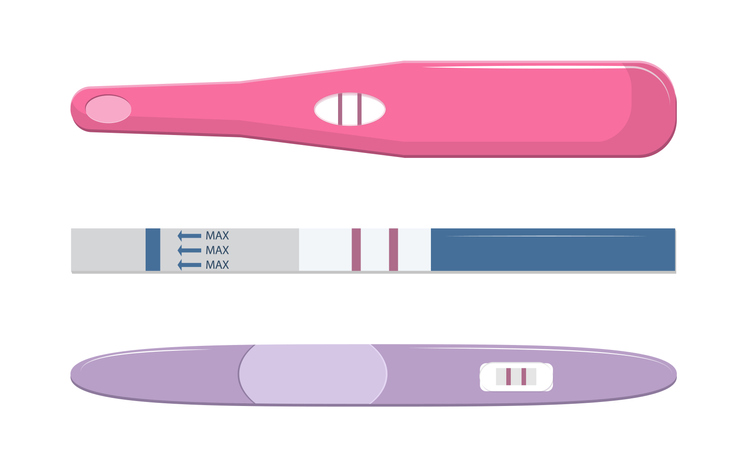Even though it can be nerve-wracking, using a pregnancy test kit is actually fairly simple and can provide accurate results in the privacy of your home. We’ve put together a complete instruction guide for how to use a pregnancy home test.
Keep in mind that these are general instructions, and while we hope to help clarify some of the language that comes with the instruction booklet, you should still always take time to review the instructions that come with your specific text kit.
With that, let’s dive in.
How Do Pregnancy Tests Work?
Pregnancy tests work by detecting a certain level of human chorionic gonadotropin, commonly shortened to hCG.
HCG is called the “pregnancy hormone” because it’s produced at higher levels during pregnancy; specifically, the body begins to produce hCG in the cells that form the placenta, and the hCG gets distributed through the bloodstream from there.
Most pregnancy tests measure the presence of the hCG hormone in the urine, where it appears about 12 to 14 days after conception.
HCG can also be measured by blood tests in a doctor’s office about 10-11 days after conception.
Generally, the amount of hCG in a woman’s body doubles every 72 hours for the first 8 to 11 weeks of pregnancy before declining and leveling off for the rest of the pregnancy.
The amount of hCG in a woman’s urine influences the accuracy of the pregnancy test.
How To Use a Pregnancy Test
At-home pregnancy tests are highly accurate when used as directed.
Regardless of whether or not you use a simple and inexpensive pregnancy test kit from the drugstore or opt for a test with additional features like a digital readout, the steps are generally the same.
- Open the pregnancy test wrapper and remove the test stick.
- Remove the plastic cap to expose the absorbent tip of the test.
- Holding the pregnancy test firmly in your hand, place the absorbent end of the test directly into your urine stream and hold it within the stream for at least 7 to 10 seconds. If you find this method to be challenging, you can also take the test by collecting the urine in a clean, sterile container, and dipping the absorbent end of the test into the urine for 7 to 10 seconds. Some kits may also come with a sterile container, with dipping the test stick being the given instructions for that particular kit.
- After soaking the absorbent end of the test in urine, replace the plastic cap.
- Place the pregnancy test flat on a clean, level surface, facing up.
- Wait the appropriate amount of time as directed by the test (usually 3 to 5 minutes).
- Check your results.
Most pregnancy tests will show one line (the control line) for a negative test result and two lines for a positive test result.
The control line typically appears dark, while the test line may be a light, faint line.
The amount of hCG detected in the urine will often affect how dark the line appears. Thus, the earlier you test in the pregnancy, the lighter the test line will be. Note that even a very faint test line can indicate a positive result.
What Influences the Accuracy of a Pregnancy Test?
As noted above, pregnancy tests are highly accurate when taken as directed. However, there are some circumstances that can affect the accuracy of a pregnancy test.
False Negative Pregnancy Test
A false negative pregnancy test is much more likely to occur than a false positive test.
The primary reason why women experience a false negative pregnancy test is taking the test too soon after conception, before the hCG has had time to build up in the urine and blood.
Pregnancy tests are most accurate when taken at least after the first day of a missed period, or at least 7-10 days after unprotected sex.
Taking the test before a mised menstrual cycle can result in a false negative result since the body hasn’t had enough time to produce enough hCG to produce a positive test result in very early pregnancy.
Another explanation for a false negative pregnancy test result is diluted urine. HCG is most concentrated in the urine in the morning, so the test should be taken with the first bathroom visit of the day.
If that’s not possible, women should try to avoid drinking too many fluids in the hour or two before taking the test to allow the hCG to become more concentrated.
User error can also result in a false negative pregnancy test.
Improper use of the test, such as failing to hold the absorbent tip in the urine stream for long enough, improper placement of the test while waiting for the result, failing to notice a passed expiration date, or not waiting long enough for the result can also contribute to a false negative test.
False Positive Pregnancy Test
False positive pregnancy tests are much less common than false negative tests, but they can happen. T
here are six primary causes for a false-positive pregnancy test: evaporation lines, medical conditions, recent pregnancy loss, ectopic pregnancy, user error, and the use of certain medications.
Evaporation lines can create the appearance of a positive test result if a pregnancy test is left to sit too long before reading the results.
Medical conditions that may result in a false positive pregnancy test include:
- Molar pregnancy
- Certain types of ovarian cancer
- Hydroxychloroquine (HCQ) injections
- Urinary tract infection
- Chemotherapy
- Kidney disease
- Rare antibodies
- Pituitary problem
Recent pregnancy loss, such as miscarriage or abortion, can contribute to a positive pregnancy test, as elevated levels of hCG may remain for several weeks.
Because the body starts to produce hCG, the elevated levels may remain high enough to trigger a positive test result even if the miscarriage has already occurred.
A chemical pregnancy, specifically, is a common type of miscarriage that occurs in the first five weeks of pregnancy, often before a woman knows that she is pregnant.
An ectopic pregnancy occurs when a fertilized egg implants and begins growing outside of the uterus, typically in the fallopian tube. This pregnancy is not viable but will trigger the body to start producing hCG, which can cause a false positive pregnancy test.
User error such as administering the test incorrectly or using an expired test can also lead to an inaccurate result.
While pregnancy tests may be taken at any time of the day, they’re best taken in the morning when hCG levels are most easily detectable in pregnant women.
Certain medications, including fertility drugs, can trigger a false positive pregnancy test. These medications include:
- Fertility medications like Novarel, Pregnyl, Ovidrel, or Profasi
- Anti-anxiety medications, like Valium (diazepam) or Xanax (alprazolam)
- Antihistamines, including promethazine
- Dolophine (methadone)
- Anticonvulsants, like phenobarbital or other barbiturates
- Diuretics, like Lasix, Diuscreen (furosemide)
- Antipsychotics, such as clozapine or chlorpromazine
- Parkinson’s disease medications, including Parlodel (bromocriptine)
The Bottom Line
Taking an at-home pregnancy test can be simple and highly accurate when used as directed.
When taking an at-home pregnancy test, be sure to place the absorbent tip of the test directly into the stream of urine for 7 to 10 seconds, preferably during your first bathroom visit of the day.
Replace the plastic cap, place the test strip on a flat surface, and wait 3 to 5 minutes before reading the results.
References and Sources:
Causes of a False Positive Pregnancy Test | Cleveland Clinic
Pregnancy Test Instructions | UNC Medical School
hCG Levels | The American Pregnancy Association

Bridget Reed is a Tampa-based content development manager, writer, and editor at GR0; specializing in content related to varying fields including medicine, health, and small businesses. Bridget went to St. Petersburg College and majored in Management and Organizational Leadership.
Recent Publications: Body Acne 101: Prevention and Treatment, Stress Acne: Causes, Prevention, and Treatment, What are the Side Effects of Midol?

